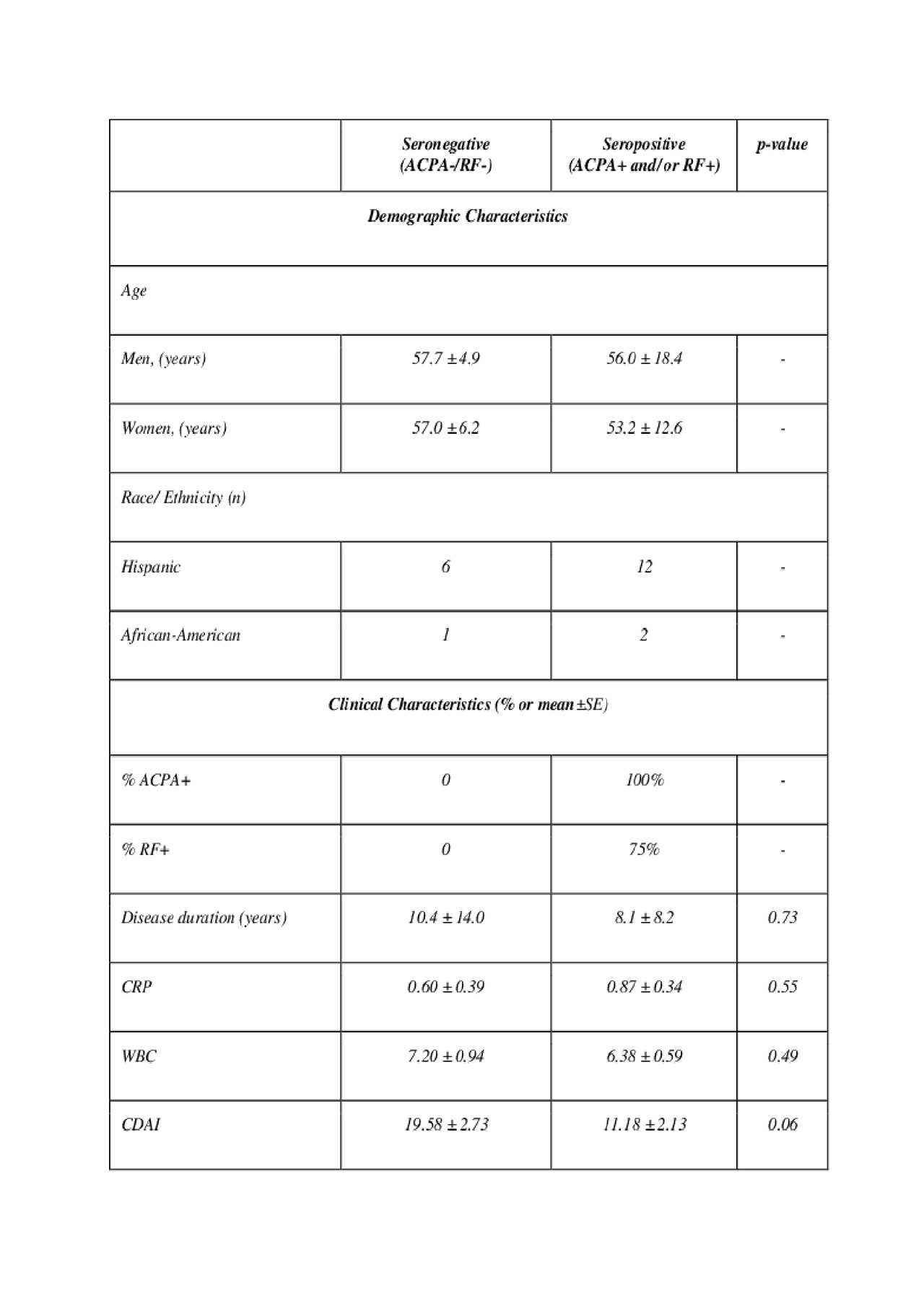Session Information
Date: Sunday, November 10, 2019
Title: RA – Diagnosis, Manifestations, & Outcomes Poster I: Risk Factors, Predictors, & Prognosis
Session Type: Poster Session (Sunday)
Session Time: 9:00AM-11:00AM
Background/Purpose: Rheumatoid factor (RF) and anti-citrullinated peptide antibodies (ACPA) are biomarkers that allow early diagnosis of RA in seropositive (ACPA+ or RF+) patients. However, some subjects are seronegative (ACPA-/RF-). In addition to a lack of markers to identify ACPA- patients, researchers hypothesize that different serotypes reflect distinct pathogenic and disease entities. RA is mediated by a complex interplay between genetic and environmental factors that mirrors epigenetic deregulation. Recent research has focused on understanding the role of microRNAs (miRNAs), a type of epigenetic modification, in RA. Studies have identified altered expression patterns for miRNAs in synovial fluid and plasma of RA patients, suggesting that changes in miRNA underly the molecular mechanisms of the disease. However, research has not investigated whether miRNA expressions differ by serotype status. In this study, we investigate plasma extravesicular miRNAs associations with serotype and other clinical features of RA. We also attempt to identify whether miRNAs can discriminate seronegative from seropositive RA.
Methods: We recruited 20 patients who satisfied the ACR criteria for RA. The population included 14 seropositive (ACPA+ and/or RF+), and 6 seronegative (ACPA- and RF-) patients. 800 EV miRNAs were extracted from plasma circulating extra-vesicles, and measured using a Nanostring nCounter Human v3 miRNA expression panel. Data was normalized using nSolver software. Statistical analysis was carried out to determine miRNA differences by serotype and to identify miRNA correlations with rheumatoid factor (RF), anti-citrullinated peptide antibodies (ACPA), disease activity index (CDAI), Simple Erosive Narrowing Score (SENS), neuropathic pain (ID pain), Toronto Clinical Neuropathy Score (TCNS), Neuropathy Symptom Score (NSS), and disease duration. Discriminant function analysis was used to investigate whether miRNAs could discriminate between serotypes.
Results: Five miRNAs (miR-1261, miR-4532, miR-802, miR-595, miR-373-3p) were differentially expressed between seropositive and seronegative RA (p≤0.05). miR-802 and miR-1261 positively correlated with ACPA levels (Pearson Coeff.ACPA= 0.608, p=0.001) and ID Pain (Pearson Coeff.ID Pain= 0.472, p=0.041), respectively. No other RA clinical variables were correlated with miRNA levels. Discriminant function analysis identify miR-1261 (p=0.004) and ACPA (p=0.002) as the strongest biomarkers differentiating seronegative from seropositive RA.
Conclusion: Our findings suggest that EV miRNAs might underlie serotype pathogenesis in RA. One of these, miR-595, has been previously identified as upregulated in RA. We identified four new miRNAs related to RA serotype. Of all these, miR-1261 was as powerful as ACPA differentiating seronegative from seropositive patients. Interestingly, miR-1261 did not correlate with ACPA, which suggests independent roles for each biomarker in serotype biology. Further studies are needed to explore the potential of these miRNAs as biomarkers of development and progression of the disease in this population.
To cite this abstract in AMA style:
Delgado-Cruzata L, Rodriguez Alvarez M, Almodovar N, Bravo T, Hinson S. Associations of Plasma Extravesicular (EV) MicroRNA Levels in Seropositive and Seronegative Rheumatoid Arthritis (RA) [abstract]. Arthritis Rheumatol. 2019; 71 (suppl 10). https://acrabstracts.org/abstract/associations-of-plasma-extravesicular-ev-microrna-levels-in-seropositive-and-seronegative-rheumatoid-arthritis-ra/. Accessed .« Back to 2019 ACR/ARP Annual Meeting
ACR Meeting Abstracts - https://acrabstracts.org/abstract/associations-of-plasma-extravesicular-ev-microrna-levels-in-seropositive-and-seronegative-rheumatoid-arthritis-ra/

